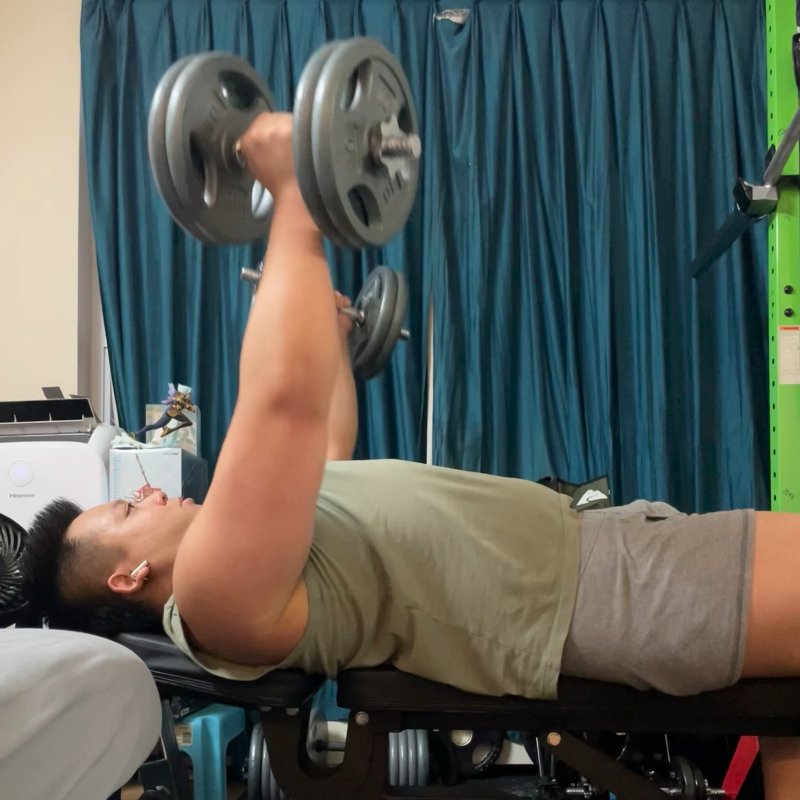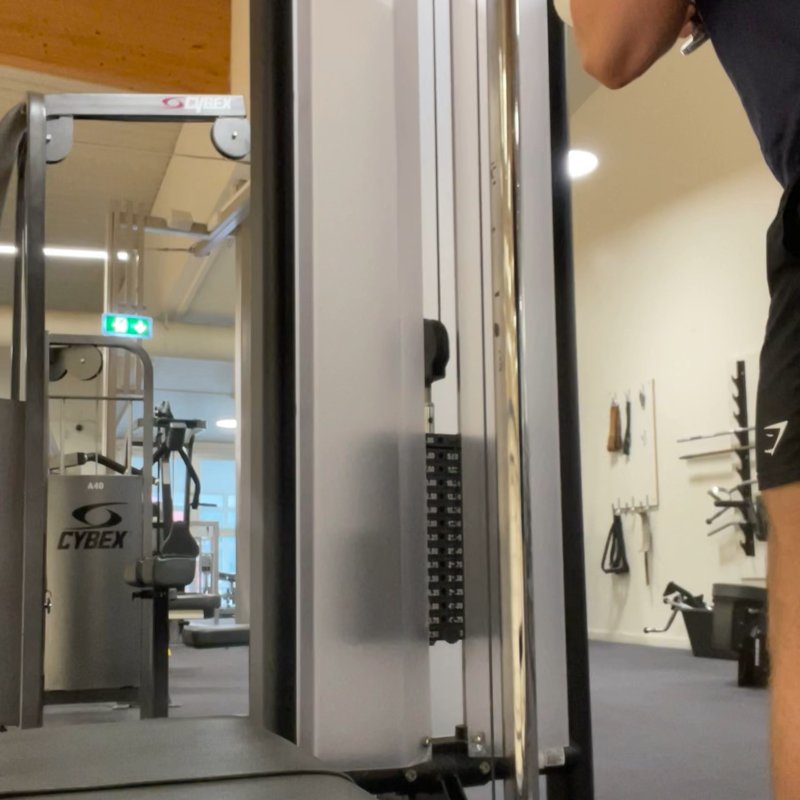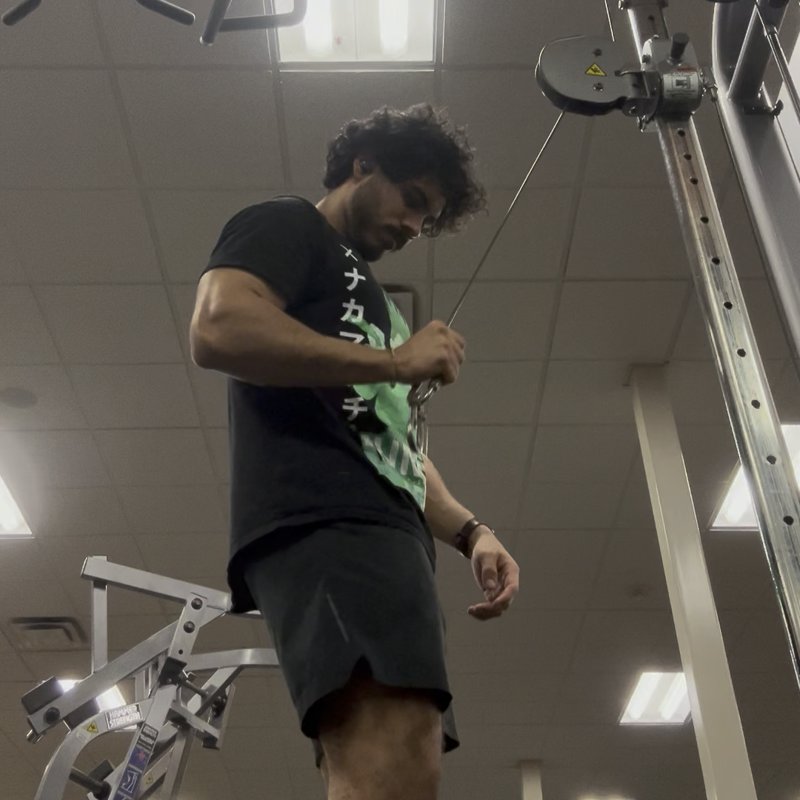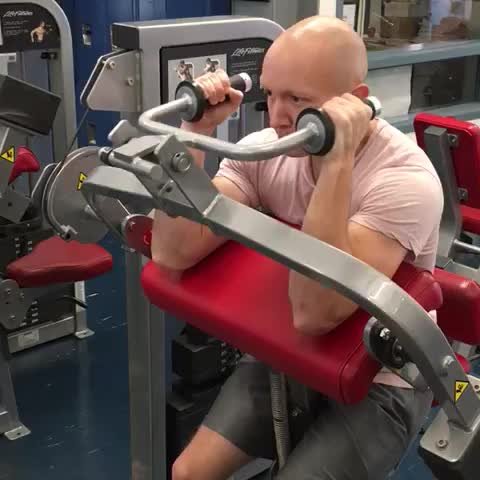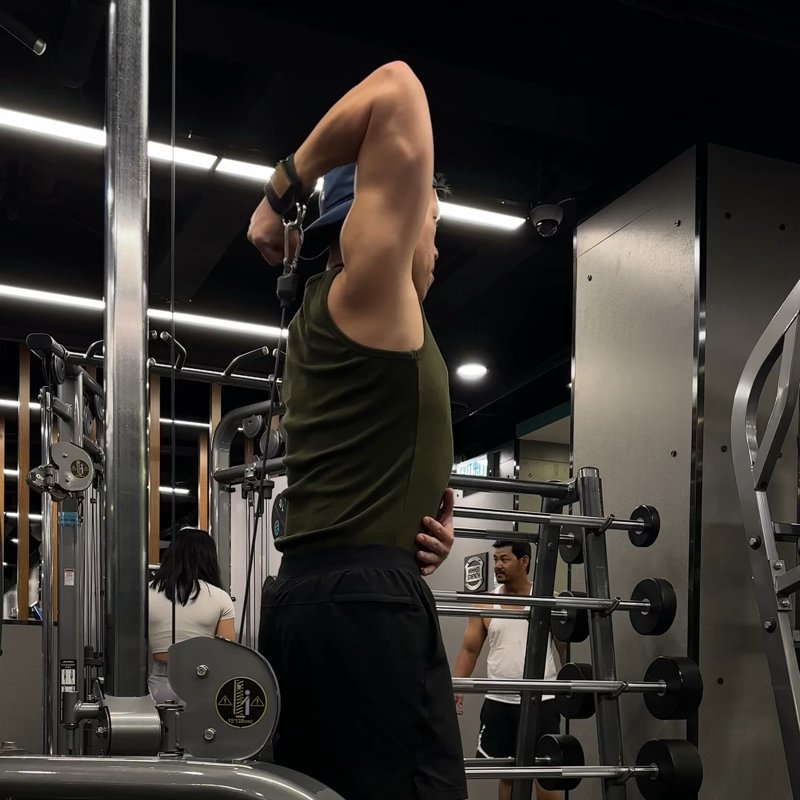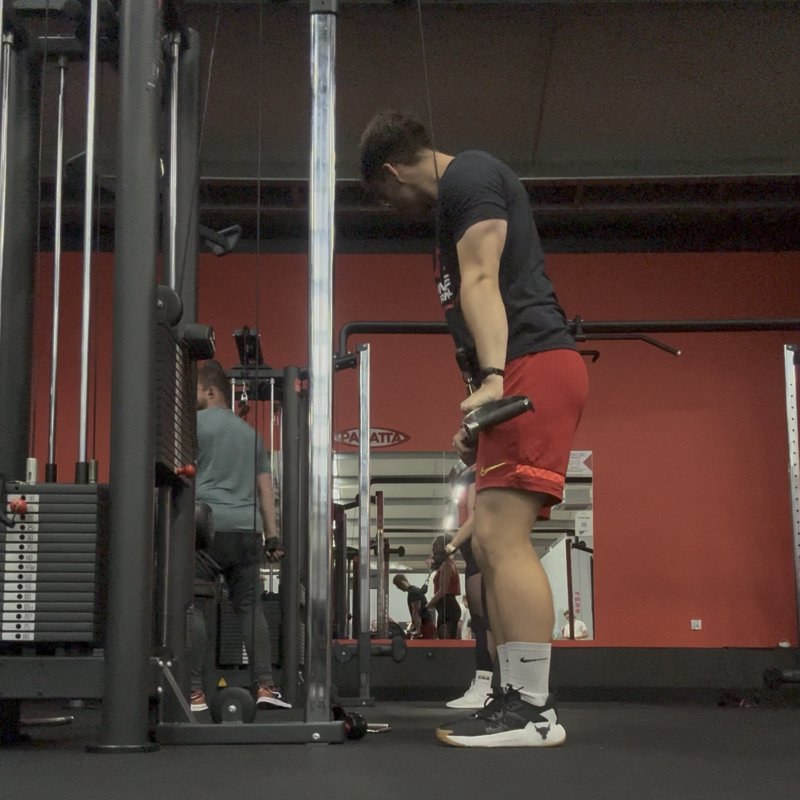Overhead Tricep Rope Extension: The Ultimate Guide
The Overhead Tricep Rope Extension is an isolation exercise that effectively targets all three heads of the triceps muscle, with particular emphasis on the long head, to build arm size, strength, and definition.
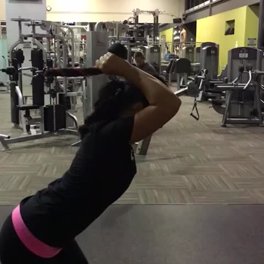
Quick Facts
Key Benefit
Long head tricep development and arm definition
Primary Muscles
Triceps
Secondary Muscles
Abdominals, Posterior Deltoids, Traps
Equipment
cable machine
Difficulty
Beginner
Type
Strength
In This Guide
Ready to master the Overhead Tricep Rope Extension?
Track your progress, see improvements over time, and build strength consistently.
Download GravitusThe Overhead Tricep Rope Extension is one of the most effective exercises for targeting the triceps, particularly the long head. This exercise uses a cable machine with a rope attachment to provide constant tension throughout the movement, making it superior to many free-weight variations. The triceps brachii is a three-headed muscle (lateral, medial, and long heads) that makes up approximately two-thirds of your upper arm mass. While all three heads work together to extend the elbow, the long head crosses the shoulder joint, which means it's most effectively stretched and worked when the arm is positioned overhead. The rope attachment allows for a natural movement pattern and wrist position at the end of the motion, enabling a more complete contraction of the triceps. Additionally, the standing position engages core stabilizers, making this a functional exercise that contributes to overall upper body development. Whether your goal is to increase arm size, improve pushing strength, or enhance arm definition, the Overhead Tricep Rope Extension deserves a place in your training program.
Benefits of Overhead Tricep Rope Extensions
This exercise offers several unique advantages for triceps development and overall arm training.
Long Head Emphasis
The overhead position particularly stretches and targets the long head of the triceps, which is the largest of the three heads and contributes significantly to arm size and shape.
Constant Tension
The cable provides consistent resistance throughout the entire range of motion, keeping the triceps engaged even at the top of the movement.
Complete Contraction
The rope attachment allows for natural wrist movement and hand separation at the bottom of the motion, enabling a more thorough triceps contraction.
Joint-Friendly
The vertical force angle and controlled nature of the exercise typically make it more comfortable for those with elbow issues compared to some free-weight triceps exercises.
Core Engagement
The standing position requires core stabilization, particularly when using heavier weights, adding functional benefits beyond isolated arm development.
Proper Form & Technique
Starting Position
- Attach a rope handle to a high cable pulley.
- Stand facing the cable machine with feet shoulder-width apart or in a split stance for stability.
- Grasp the ends of the rope with a neutral grip (palms facing each other).
- Turn away from the machine and position yourself at a distance that maintains constant tension on the cable.
- Extend your arms overhead with elbows pointing forward, keeping a slight bend in the elbows at the starting position.
- Tuck your chin slightly and maintain a neutral spine with engaged core muscles.
Movement
- While keeping your upper arms stationary and close to your head, exhale and extend your forearms downward by contracting your triceps.
- As you reach the bottom of the movement, allow your hands to separate slightly outward (following the natural design of the rope).
- Continue the extension until your arms are fully straightened, focusing on squeezing the triceps at full contraction.
- Hold the contracted position briefly to maximize muscle engagement.
- Inhale as you slowly return to the starting position in a controlled manner, allowing the elbows to bend and the hands to return together.
- Stop just before the weight stack touches down to maintain constant tension on the triceps.
- Repeat for the desired number of repetitions, maintaining proper form throughout.
Key Form Tips
Upper Arm Position
Keep your upper arms stationary and relatively close to your head throughout the movement.
Elbow Alignment
Focus on keeping your elbows pointing forward rather than flaring out to the sides.
Wrist Position
Maintain a neutral wrist position throughout the exercise to avoid strain.
Range of Motion
Achieve a full extension at the bottom without locking out the elbows completely.
Control
Avoid using momentum - the movement should be powered solely by triceps contraction.
Muscles Worked
Primary Muscles
- triceps: The three-headed muscle on the back of the upper arm consisting of the long head (innermost), lateral head (outer), and medial head (inner). The overhead position particularly targets the long head, while all three heads work together during elbow extension, creating the pushing movement.
Secondary Muscles
- anconeus: A small muscle near the elbow that assists with elbow extension and stabilization during the movement.
- posterior deltoids: The rear shoulder muscle works isometrically to help maintain the overhead arm position.
- abdominals: The abdominals, obliques, and lower back muscles work to stabilize the body during the standing exercise.
- traps: The upper and middle traps assist in stabilizing the shoulder blades during the overhead movement.
Common Mistakes and How to Fix Them
Moving the Upper Arms
Allowing the upper arms to move forward or backward during the exercise reduces triceps isolation. Fix by keeping your upper arms stationary alongside your head, focusing on movement only at the elbow joint.
Using Momentum
Swinging the weight or using body momentum makes the exercise less effective and increases injury risk. Use a controlled tempo and appropriate weight that allows you to perform the movement strictly with triceps power.
Incomplete Range of Motion
Not fully extending the arms or not allowing adequate flexion at the top reduces effectiveness. Ensure you're moving through a complete range of motion—from a slight bend at the top to full extension at the bottom.
Flaring Elbows
Allowing the elbows to drift outward during the movement reduces long head engagement. Keep your elbows pointing forward and relatively close to your head throughout the exercise.
Excessive Weight
Using too much resistance often leads to form breakdown and reduced effectiveness. Select a weight that allows you to perform 10-12 controlled repetitions with proper form before reaching muscle failure.
Overhead Tricep Rope Extension Variations
Stance and Position Variations
-

Seated Overhead Extension
Performed while seated on a bench for increased stability, allowing greater focus on the triceps without core stability demands.
-

Split Stance Overhead Extension
Using a staggered foot position for better balance, particularly useful when training with heavier weights.
-

Kneeling Overhead Extension
Performed in a kneeling position, which can increase core engagement and provide a more stable platform for the movement.
Technical Variations
-

Single-Arm Overhead Extension
Performing the movement one arm at a time for greater focus on each side and to address potential strength imbalances.
-

Paused Overhead Extension
Adding a 2-3 second pause at the point of full contraction to increase time under tension and muscle activation.
-

Descending Set Overhead Extensions
Starting with a heavier weight for fewer reps, then immediately reducing weight and continuing for additional repetitions as a form of intensity technique.
Frequently Asked Questions
Most people will see optimal results training triceps 2-3 times per week with at least 48 hours between sessions focusing on the same muscle group. The overhead tricep extension can be included in upper body push days, arm-specific workouts, or full-body sessions. If you're training triceps multiple times weekly, consider varying the exercises, rep ranges, and intensities between sessions. For example, you might use the overhead tricep extension for higher reps (12-15) in one session and a different tricep exercise for lower reps (6-8) in another session.
Generally, it's most effective to perform compound movements (like bench press, overhead press, or dips) before isolation exercises like the overhead tricep extension. This approach allows you to give maximum effort to the multi-joint exercises that build overall strength and move the most weight. However, if triceps are a specific weakness or priority, occasionally performing this exercise first in your workout when you're fresh can be beneficial. Another effective approach is to use pre-exhaustion, performing the overhead tricep extension before pressing movements to specifically challenge the triceps during the compound exercises.
Neither is universally "better" - they emphasize different aspects of tricep development. The overhead tricep extension places particular emphasis on the long head of the triceps due to the stretched position at the shoulder joint. Tricep pushdowns tend to emphasize the lateral and medial heads more. For complete tricep development, incorporating both exercise types is ideal. If your triceps lack overall size, the overhead extension might be prioritized due to its emphasis on the largest head. If you have elbow issues, some people find pushdowns more comfortable than overhead movements. The best approach is to include both varieties in your training program.
The rope attachment offers several advantages for overhead tricep extensions. First, it allows a neutral grip position (palms facing each other), which is typically more comfortable for the wrists and elbows than the pronated grip required with a straight bar. Second, the rope enables you to spread your hands slightly at the bottom of the movement, creating a more complete contraction of the triceps. Finally, the rope provides some freedom of movement rather than forcing your hands into a fixed position, allowing for a more natural movement arc that can reduce joint stress. That said, using different attachments occasionally can provide novel stimulus for continued progress.
Video Demonstrations
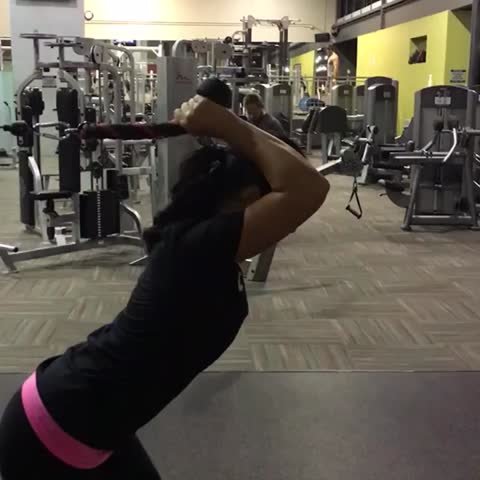
Log in to watch video demonstrations
Login to Watch3 video demonstrations available
Find more video demonstrations in the Gravitus app
Tips from the Community
-

I too, enjoy being erect while doing overhead rope Tricep extensions.
-

I do these standing erect with the elbow behind the head.
-

I like doing these usually when my triceps are blasted so I don’t use as much weight because to have to use so a heavy load can make you lose your balance.
-

Instructions unclear. Got kicked out the gym for being erect
-

Mi
Track your progress with Gravitus
Download Gravitus to log your workouts, track your progress, and join a community of fitness enthusiasts.

Helpful Resources
One Rep Max Calculator
Find your one rep max for any exercise without maximal testing. Essential for developing effective strength training programs.
Calculate 1RMWorkout Programs
Follow structured workout programs created by fitness professionals to maximize your strength and muscle gains.
View Programs